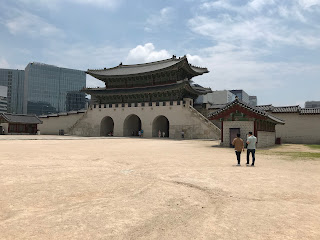Gyeongbokgung Palace was completed in 1395 and is considered to be the most beautiful and grandest of the Five Grand Palaces constructed by the Joseon dynasty, serving as the home of the kings of the Joseon dynasty as well as the government of Joseon. The palace was destroyed by fire in the 1590s and then abandoned for two centuries. In the 19th century, all 7,700 rooms in 500 buildings were restored, to be destroyed again by the Japanese in the early 20th century. Since the 1990s, the palace complex is gradually being restored to its original form.
Approaching the palace side entrance
Looking at the main entrance from inside
Looking into the palace
Traditional outfits
Further into the palace
Formal chambers
More buildings
Great rooms
Gyeonghoeru
View behind Gyeonghoeru
North of the palace were the living quarters of the queen, followed by the living quarters of the concubines, separated by a beautiful lake and gardens which served as a rear garden of the concubines' quarters.
Living quarters
Lake and gardens

























No comments:
Post a Comment